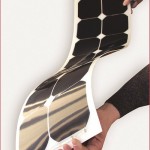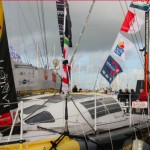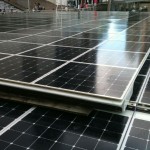 Now available in Australia the Solbianflex range of light weight flexible marine solar panels are now available from The Torqeedo Shop. These panels work as a good solar charger for the Torqeedo 1003 as well as ideal for use on any boat needing a solar array.
Now available in Australia the Solbianflex range of light weight flexible marine solar panels are now available from The Torqeedo Shop. These panels work as a good solar charger for the Torqeedo 1003 as well as ideal for use on any boat needing a solar array.
The usual metal framed rigid solar panels can be difficult to mount and often require substantial engineering to make a robust targa bar or other structure to support them. As well they can add clutter and disharmony to the lines of any boat.
Solbianflex panels are light weight—about one eighth the weight of normal panels—and can be easily added to most biminis using a zip. Because they are light they add no appreciable weight to the structure, and because they are thin, you barely notice they are there.
Being thin and flexible means you can also glue them directly to the deck or cabin top—and they are strong enough to be walked on if necessary.
For boats with small available areas for solar panels its important to maximise the efficiency of the panels and harvest as much energy as is possible from the available area. The Solbianflex SP series of panels are made using Sun Power cells with an efficiency of over 22.5%. These are the cells that were chosen by Planet Solar for their global circumnavigation. Tûranor’s cells though are of the rigid variety and have the usual metal frames of typical solar panels. The advantage of the Solbian panels is that they van be glued to the deck without the need for supporting framework. This makes a much neater and lighter installation.
Solbianflex also come in a more economical design for boats which do not need to capture the maximum harvest for the available area. These are the CP and SL series, which are still highly efficient panels and have the same flexibility and lightness as the SP series.
Installation notes
Please note that the smaller size panels, 40 and 50 watts, have an output voltage of around 9 volts and can’t be used directly connected to your battery bank or through an normal solar regulator which is expecting a voltage of around 16 to 18v. You’ll need to order a Solbian regulator for charging a normal battery, or a voltage booster for charging a Torqeedo battery.
The larger panels output their energy at 16 to 18v and these can be used directly with an everyday solar regulator.
The smaller panels can be strung in series of two to be similar to a nominal 12v panel, and a series of four to create a nominal 24v panel (such as is needed for the Torqeedo 1003 battery).
Don’t worry, its a simple matter to install them when you have the right bits—they simply plug together and you’ll be up and running in no time. If you have any questions just ask on the enquiry page and we can advise how best to set up a system for your boat.





Hi,
is there a way to lock down the battery on the 1003 so it can not be stolen ?
Thanks,
Jules
Hi Jules,
I suggest you use a bicycle locking cable that can be passed through the handle of the battery and locked to the boat and also locked to the frame of the 1003. On the 1003 there is a hole in the frame where the battery attaches that can be used for securing to the battery and to the boat.
Cheers
Chris
Dear Chris,
can I not use a 16v or 18v solbian flexable panel to charge my Torqueedo 1003 battery directly?
Does it realy have to be 24v?
Please what are the differences between watts and volts?
I hope you have time for this question.
Thanks.
There are two charge channels that operate through the charging socket of the battery. The normal charge channel which the charger uses, expects to have 12v coming in to it. If the voltage is higher, over 30v I think, the battery detects that it is a solar panel, and uses a different charge circuit internally. This voltage needs to be more than the Torqeedo battery voltage which can be as high as 33.6 volts. To use Solbian panels you need two of those that you mention, linked in series. If we think of water it gives good analogy for electricity. Volts is like water pressure. If you have your thumb over the end of the hose, the pressure in the hose is high. Watts is a measure of the power of the water. If your thumb is over the hose, no water is coming out, and there is no power available because nothing is happening. Same with electricty, you can voltage, such as you measure on a battery, but if it is not flowing anywhere no work is done. When you connect a motor or a light to the battery, the current flows and you have some power which is measures in watts. Watts is volts x amps. I hope that helps. cheers, chris